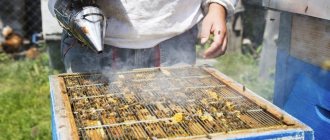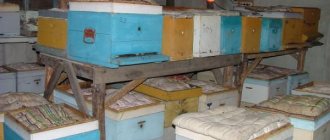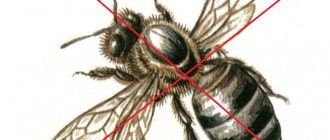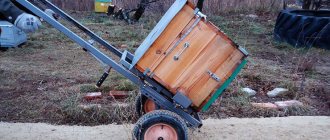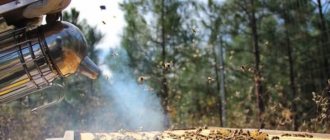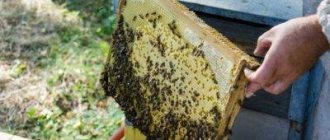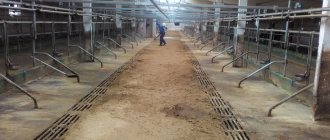If you are a beekeeper, then you know how to maintain your hives and take care of your bees. Sometimes situations arise when you need to move hives from their current location. For those looking to move their hives, this step will require a lot of advance research and planning. And the main thing you need when transporting them is a high-quality and safe trailer. How to make an inexpensive and reliable trailer for transporting beehives with your own hands.
Why do you need to transport bees?
Every beekeeper knows that changing the location of the hives is one of the main conditions for the normal functioning and development of bee colonies. In addition, changes in habitat affect the quality of honey. Often honey fields are located far from the apiary, and it is difficult for bees to travel a long distance.
Long flights also affect the productivity of honey bees, because the further they fly for nectar, the less honey they collect. To improve the quality of honey collection and increase the population, bee hives must be transported in the fall or spring, which will significantly reduce losses among insects during the move.
The bees experience less discomfort, because the temperature inside the house will be reduced. The apiary needs to be moved in the direction of a region where as many different honey plants as possible grow - the more flowering crops are located near the hives, the more harvest the beekeeper will receive.
Important! A minimum transport distance of 4 km must be maintained, otherwise some bees will return to their original location and this may destroy the colony.
Ready-made models
If there is such an opportunity, then it is best to purchase ready-made trailers for hives for a car or truck. Let's look at the most popular models.
817730.001
This is a biaxial design that is highly stable and has virtually no swaying, which is an important factor when transporting bees in hives in a passenger car. Fastening is carried out through a V-shaped drawbar. The carrying capacity of such a trailer is up to 450 kg.
Progress
This design has sides 0.15 m high. The springs absorb road unevenness quite well, which makes it possible to move over not entirely comfortable and level terrain. Capable of carrying 560 kg of cargo.
Tandem
This design is also biaxial, but its dimensions are significantly larger than those of the previous product. When placing hives on long sides, there is a passage of about 1 m wide between the rows, which allows the beekeeper to work quite comfortably.
Using this trailer for transporting beehives, transportation can be carried out both short and long distances.
Axis
The second name of this design is “Saddle Apiary”. It allows you to place houses in several rows without compromising their ventilation. Its carrying capacity is respectable and amounts to 1.5 tons.
In addition, one of the advantages is the presence of a retractable cassette, which allows you to additionally place 8 hives.
MZSA
This type of platform has a single-axle wheelbase. Capable of transferring 360 kg. Special profile structures are installed along the sides, which make it possible to conveniently place the houses. There are planes along the front and rear side surfaces that can be expanded to a horizontal position and aligned with the bottom of the trailer. This allows you to increase the working plane and provides additional comfort.
Types of trailers for transporting beehives
Transportation of hives is very important for the beekeeping process, but failure to comply with the rules during transportation can harm insects, therefore, when starting to roam, you need to be well prepared.
There are the following types of trailers designed for transporting hives:
- car trailer;
- platform;
- pavilion.
You can move hives a short distance yourself using a cart - such transportation on a small cart will be quite feasible for many.
Car trailer
Hives are transported over long distances in the back of a truck. Small apiaries can be transported in a car trailer.
Did you know?
One bee colony has 50 thousand individuals and weighs 5 kg.
To avoid harming bees when moving, you must follow these recommendations:
- To reduce the impact of vibrations on insects when the machine moves, you need to cover the bottom of the platform with straw.
- The honeycombs should be placed parallel to the sides of the vehicle.
- Maintain a 10 cm interval between hives.
- The apiary should be loaded and unloaded with extreme caution.
- When driving a vehicle, it is recommended to maintain a speed of no more than 50 km/h.
- Strengthen the frames tightly so that they do not move when moving.
Platform
The platform is a miniature apiary on wheels with a capacity of 50 hives. It can be single-axis or biaxial.
- Advantages of using the platform:
- can be multi-tiered;
- it is possible to install a cover that protects the hives from rain and sun;
- The vertical arrangement of bee houses makes it easier to remove the honeycombs.
Pavilion
The transportation pavilion not only serves as a means of moving bee houses, but also serves as their permanent storage place. Typically, pavilions are divided into working and living parts. The pavilion with a volume of 45 m³ can accommodate 30 houses, arranged in 3 tiers of 5 houses on each side of the platform.
There are 3 types of pavilions:
- stationary, which do not have wheels for movement;
- mobile;
- cassette - have cells for bee houses.
Pros and cons of mobile beekeeping
Transporting hives is one of the methods of beekeeping. It has positive and negative sides, which the beekeeper is recommended to familiarize himself with in advance.
Advantages and disadvantages
The bee population is increasing;
The quality of honey increases;
The number of varieties of honey products is increasing;
The quality of plant pollination increases (this is an important plus for agricultural crops).
The disadvantages of the method include additional financial expenses for the purchase of a trailer.
If transportation rules are not followed, insect mortality increases.
How to make a trailer for transporting bees with your own hands
To make a trailer yourself, you need to prepare a drawing of the platform. For the base of the product, you need to take a cart; an old example of a trailer from OZPT-Sarmat would be an excellent option.
To manufacture the platform, the following materials and tools are required:
- profile pipe 25×50 mm - 12 m;
- profile pipe 20×40 mm - 24 m;
- corners 4×180 mm - 2 pcs.;
- corners 4×60 mm—10 pcs.;
- iron loops - 10 pcs.;
- round pipe 20×240 mm - 3 pcs.;
- plastic panels 10x180 cm - 20 pcs.;
- a sheet of steel, the size of which is calculated according to the drawing depending on the dimensions of the product;
- bearings - 8 pcs.;
- plywood 16 mm thick to form the bottom of the trailer;
- welding machine.
The production of the platform must begin by lengthening the frame by 1 m with a profile pipe and installing the chassis on the trailer.
Did you know? A bee can recognize the smell of a flower at a distance of 1 km.
Step-by-step platform assembly:
- Make a frame measuring 2.4x1.8 m from a 25x50 mm profile pipe. To ensure structural strength, cross-weld pipes of a smaller cross-section (20x40 mm) every 0.5 m.
- Using a welding machine, weld the resulting structure to the cart. Mark the resulting platform into 3 parts.
- To locate the bee houses at the bottom of the platform, construct retractable sleds.
- Make the frame for the sled from a 25×50 mm profile pipe.
- Using 10 corners 4x60 cm, which are attached to the bottom of the structure, distribute places for the hives, 5 on each side.
- Install 5 iron loops on both sides of the sides to tighten the hives.
- Line the bottom of the frame with a sheet of steel.
- Distribute the bearings throughout the frame to ensure the mobility of the slide.
- Cover the bottom of the platform with plywood on top of the steel sheet.
- At the corners of the frame, weld racks from a 20x40 mm profile pipe with a height of 1.55 m.
- At the location of the slide, on each side of the platform, install 2 racks made of a 20x40 mm profile pipe with a height of 1.65 m.
- Reinforce the drawbar of the resulting structure with a round pipe measuring 20x240 cm, passing it to the middle of the platform.
- Weld 2 corners measuring 4x180 cm to the drawbar at an angle.
- Build a canopy from the remaining corners and cover it with plastic panels.
Features of using trailers
Car trailers made by yourself must be used only for their intended purpose, observing the scale of the product, which should not exceed the maximum permitted limits of traffic regulations. It is necessary to inspect the trailer as often as possible, which consists of aligning bent parts damaged due to impacts when driving over bumps, and tightening fasteners.
When towing bee colonies, it is unacceptable to exceed speed - this will lead to the wobbling movement of the cart. When moving, you must not brake sharply, or distribute the cargo being transported unevenly, otherwise the cart will tip over.
You will be interested to know how to make a pavilion for bees with your own hands.
Baltex towbars: advantages, customer reviews
The traffic rules regulate the requirements for the movement of trailers with cargo:
- Speeding is prohibited;
- you cannot overtake - this will lead to the wobble of the cart, followed by its overturning and the death of bee colonies, a serious accident;
- Sharp braking is not recommended - it provokes uneven distribution of the load on the platform.
A properly selected trailer and following the recommendations for moving hives will allow you to get a good amount of honey. A careless attitude and ignorance of the rules will cause the death of bee families, their illness, and weakening.
Loading work
Useful tips for beekeepers
Tips from experienced beekeepers:
- It is inconvenient to wander alone, so it is better to join a group.
- Before transportation, you must select a location for the apiary. Sometimes transportation can be carried out 500 km from home, but do not be afraid of such long distances - after all, the costs will be paid off by high-quality honey collection.
- To choose the right place for an apiary, you need to contact the district livestock specialist, and also obtain permission to place the apiary from the owners of the state farm. Installing an apiary in the forest will require permission from the forestry department.
- After the honey harvest, the bees become stronger and their anxiety increases. The combs contain a large amount of unripe honey, which leads to increased humidity in the middle of the nest and the risk of comb breakage. To prevent a tragedy, when moving, you need to remove the frames filled with honey and insert empty ones instead.
- When transporting in the spring, when the bee colony is not yet strong and the nest contains a small amount of honey, it is necessary to lay a clean canvas over the frames, clamp it with strips and hammer it with nails, which will provide protection from the cold.
- When transporting in summer and autumn, loose burlap should be stuffed onto the sides of the beehives. If the house does not contain sides, empty frames must be placed on it, onto which burlap must be nailed. The material serves as ventilation and does not let in much light, thereby preventing the temperature inside the nest from rising.
Transportation of bee colonies to tracts of honey-bearing plants allows obtaining high-quality and high honey collection. The apiary roaming is carried out using special trailers, which allow bee colonies to be quickly and reliably moved to the place of nectar collection. Building such a trailer with your own hands will require time and effort, but as a result you will get a lot of tasty, aromatic and healing honey from your bees.
Pavilion
This type of structure, such as a pavilion, can be used both for transporting hives and for year-round maintenance of bee colonies. As a rule, the pavilion consists of two compartments: domestic and working. Experienced beekeepers believe that the optimal size of the working compartment is 2.5 m by 5.6 m. This area allows you to install 60 hives in 2 three-tier rows. Light comes from sliding sunroofs equipped on the roof. If wintering is provided, the walls of the pavilion are insulated. The household compartment is located in the front part and occupies an area of 2.5 m by 3 m.

